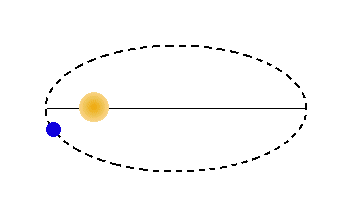Overview[edit | edit source]
This project is meant to help model and visualize orbits of planets at varying eccentricities and what the effect of the planet's eclipse looks like.
Orbit Visualization[edit | edit source]
Orbits are conic sections. This educational tool only covers closed conics: ellipses and circles. An ellipse (https://en.wikipedia.org/wiki/Ellipse) in the field of orbital mechanics where the secondary (smaller) body orbits a larger body at an eccentricity >0 and <1. This means that the elliptical orbit has two separate foci, with the primary (larger) body at one focus and the apogee of orbit at the other focus.
Elliptical orbits are not seen in physical educational aids because versions using gears are not easy to manufacture. This version uses a track for ease of assembly and use. The openSCAD model used to create this build is parametric and will produce different orbit paths based on semimajor axis (a) and semiminor axis (b) inputs. Now, students can use an easy-to-assemble model of an orbit system and be given the freedom to design it any way they see fit.
Eclipse Modeling[edit | edit source]
 |
| Animated gif of elliptical orbit |
Once an orbit track/model is created, the user can learn about eclipses and what they look like to an outside observer. There are two main types of eclipse Solar and Lunar. Solar eclipses occur when a moon goes directly between a planet and a star, and a lunar eclipse takes place when a planet goes directly between a star and its moon. More info can be found on this NASA website here: https://spaceplace.nasa.gov/eclipses/en/.
To set up the experiment, (1) print out several orbit tracks with varying eccentricities (2) setup your phone away from the setup at a fixed distance and turn on the phone light in the direction of the experiment (3) move the secondary body along the orbit track (4) observe how the change in angle and distance from the primary body effect the size and direction of the eclipse.
Tools and Links[edit | edit source]
- The CAD and STL files can be found here in MyMiniFactory.
- The print was designed in openSCAD, sliced in Cura, and printed with an AthenaII Printer.
- Additional sanding for better press-fitting may be required
- You need to provide your own flashlight. The light on the phone will suffice
Similar Educational tools[edit | edit source]
Similar educational tools were searched for on Yeggi. While there were a few similar printable models available, they all used circular orbits and did not consider using it as a testbed for demonstrating an eclipse. This print model can be used to show eclipses and elliptical orbits - which other models do not do
- This elliptical orbit package from Flinn Scientific costs $25 for a 2D drawing kit.
- This elliptical orbit package from Boreal Science costs $67 for a 2D projector kit.
- These only get more outrageously expensive from here.